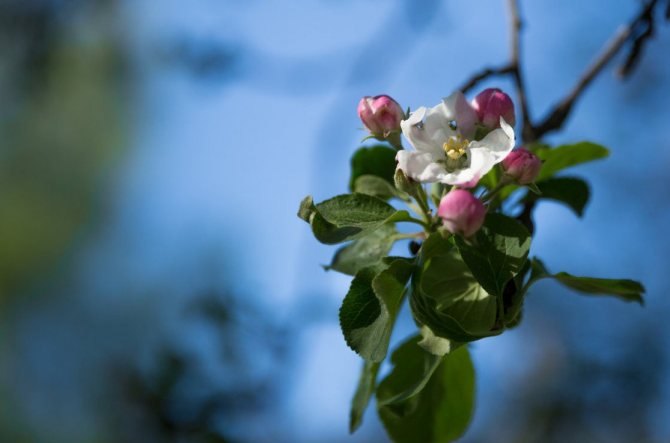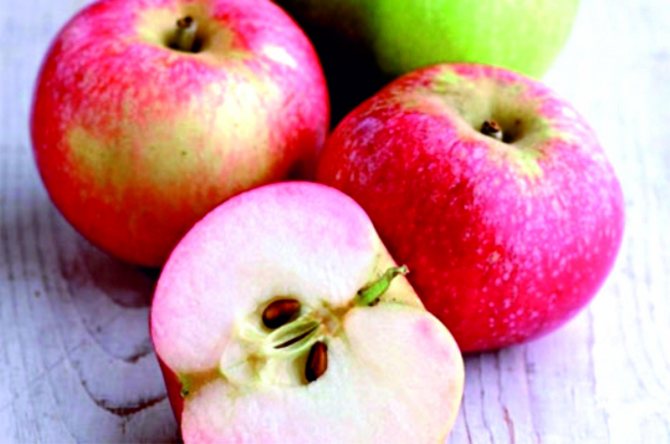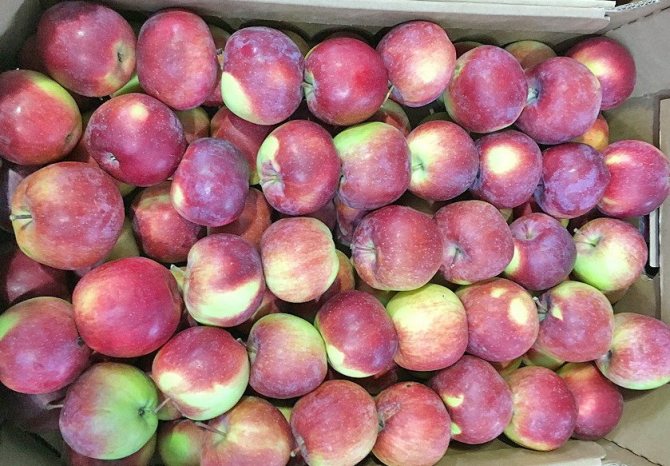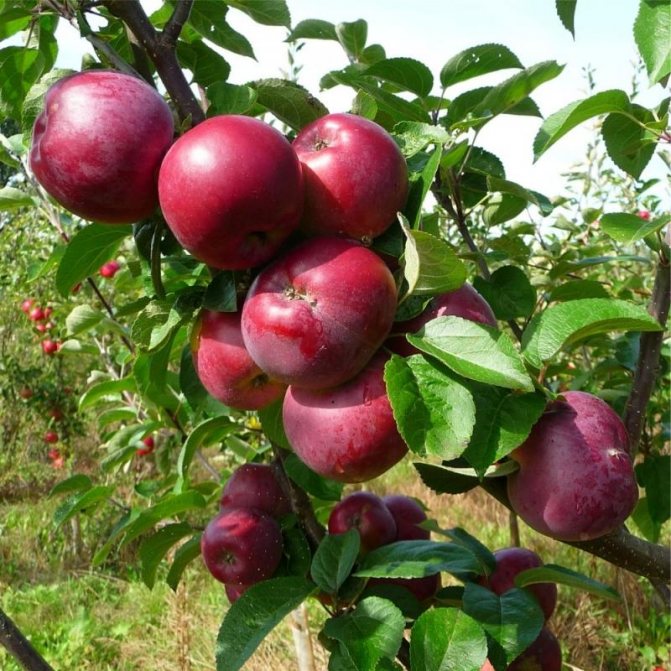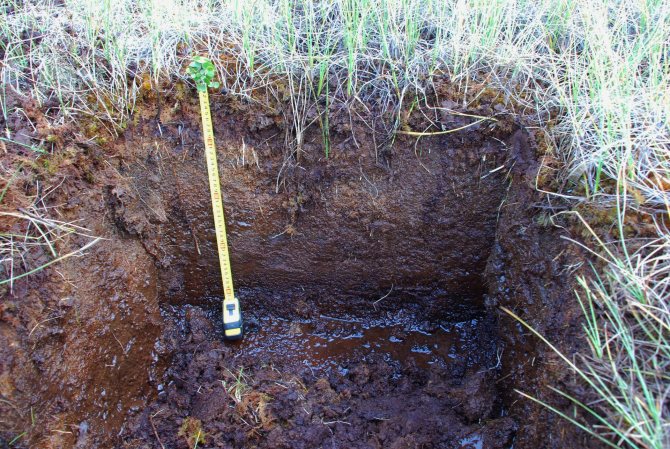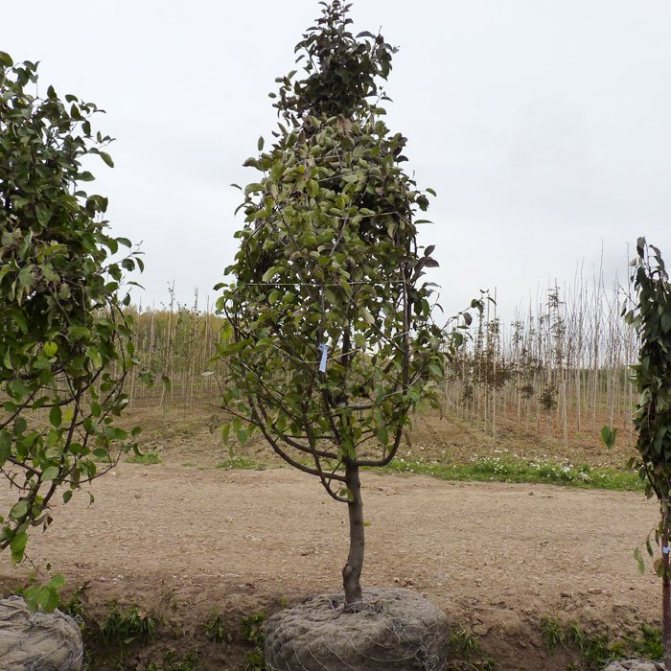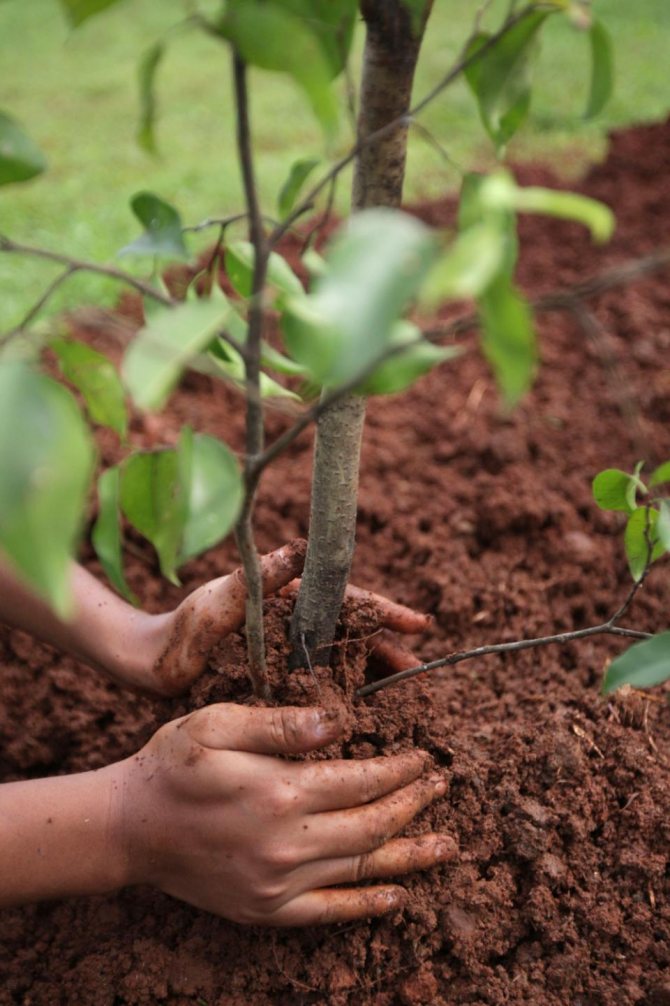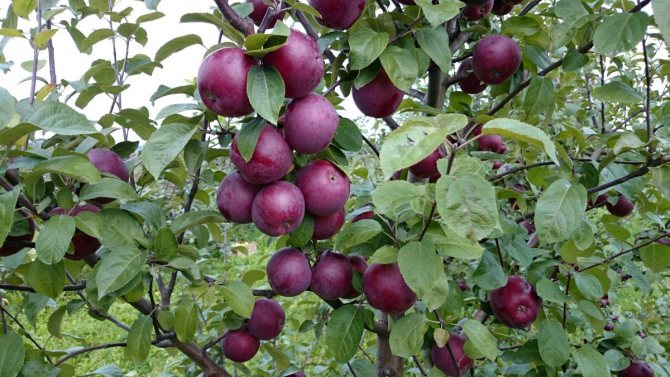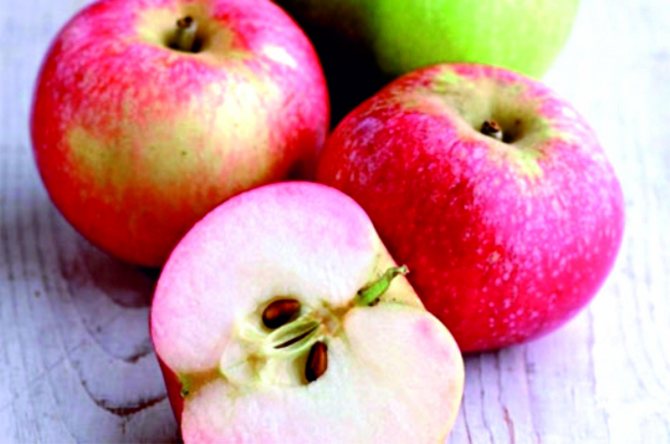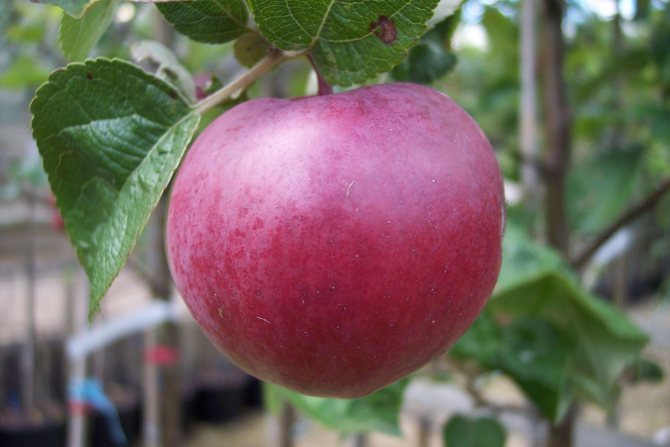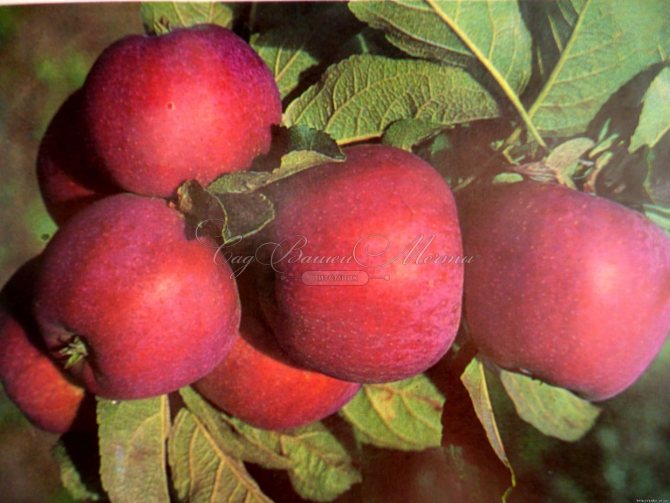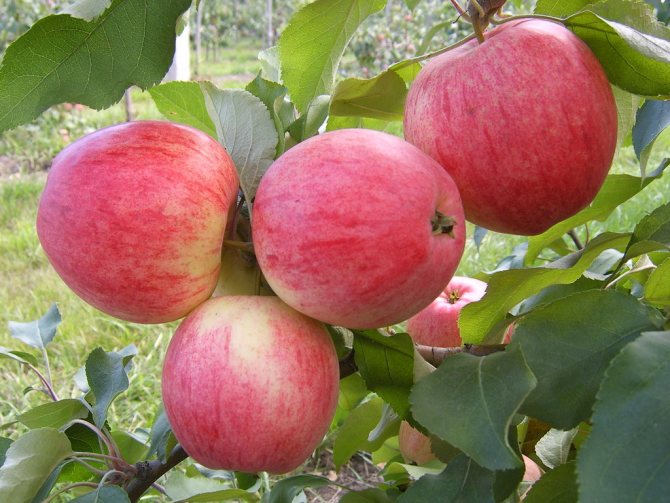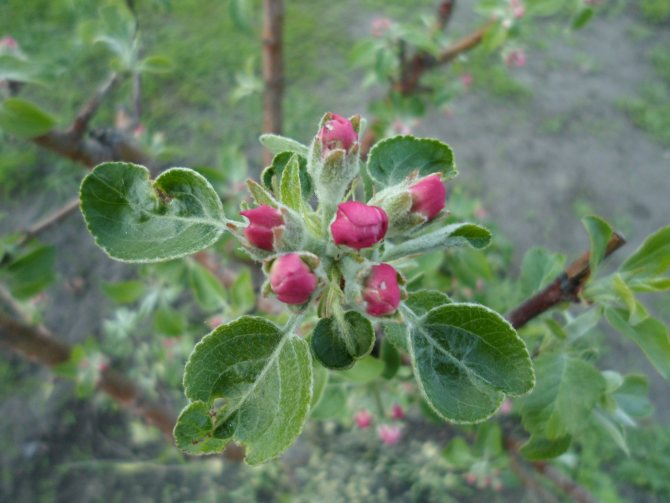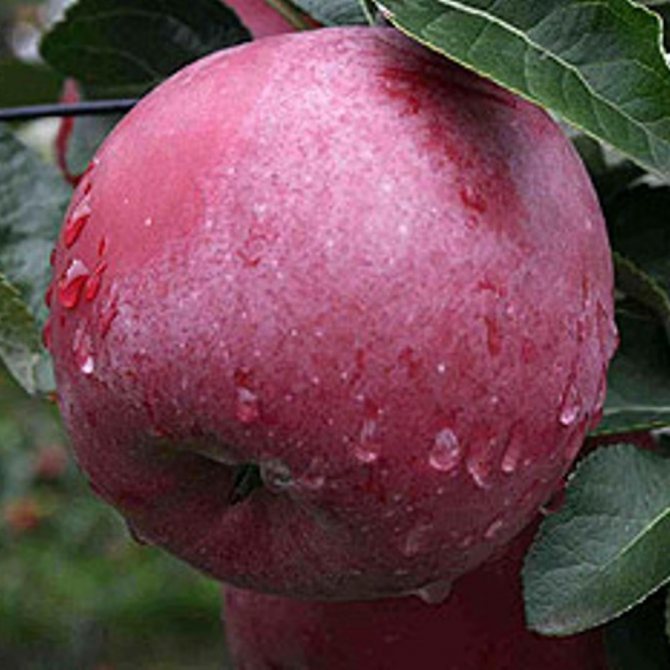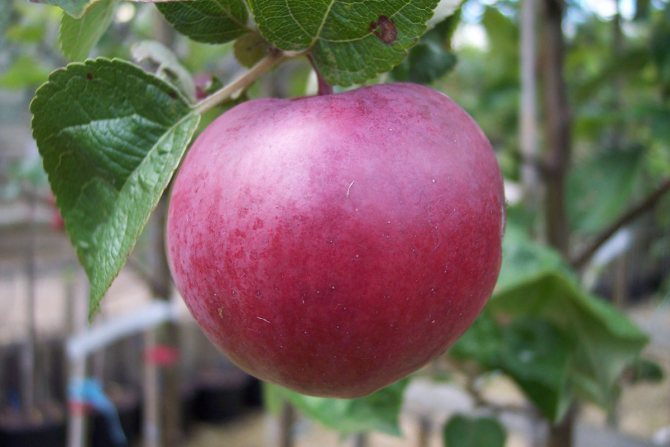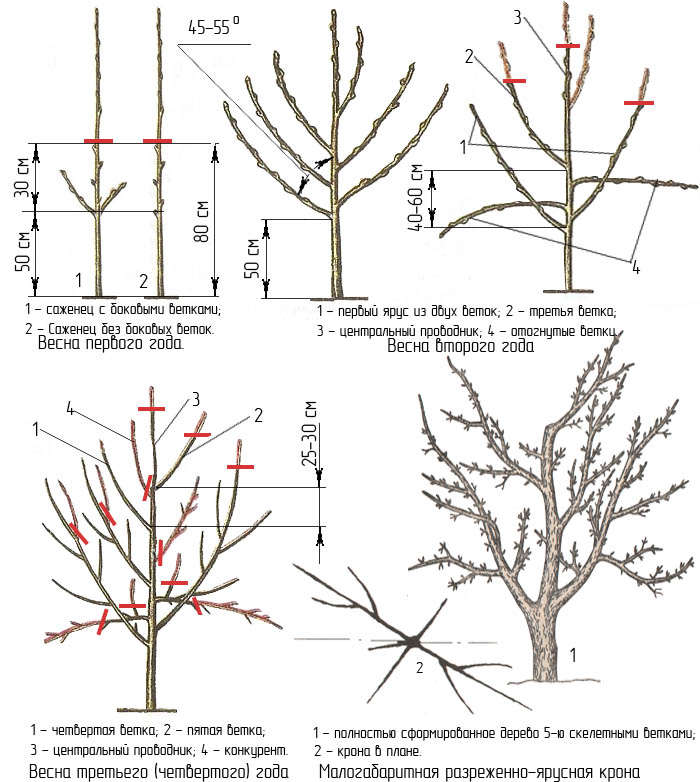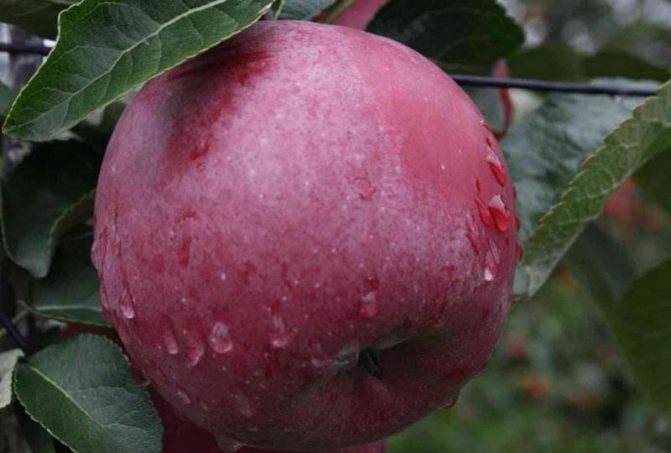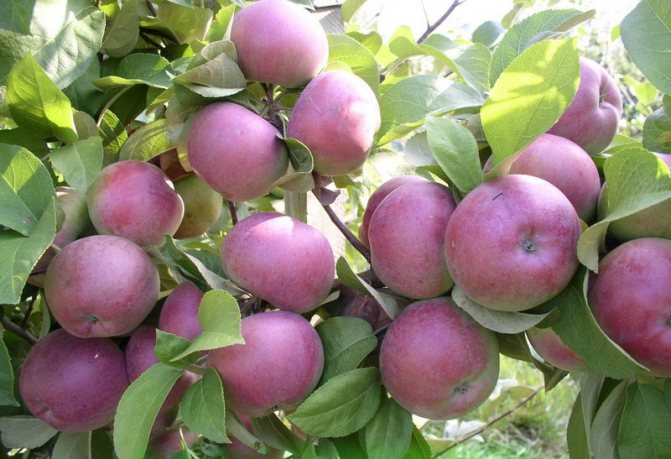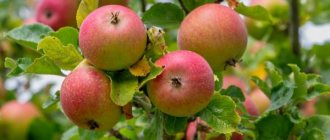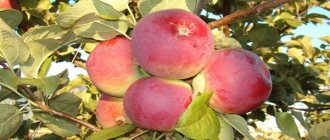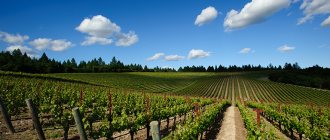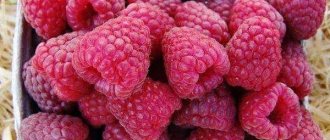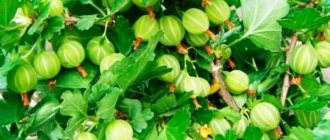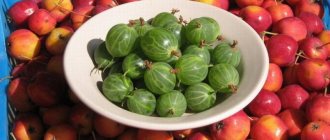The apple tree is the most common fruit crop on an industrial scale.
Thanks to selection, many different varieties have been bred for different climatic conditions.
But every gardener wants to plant apple trees, not only domestic selection, but also foreign.
Among the latter imported from abroad varieties is the Spartan apple tree. Having considered all its characteristics and features, we will find out if this variety can also gain its popularity in Russia, as well as in its homeland in Canada.
Description of the variety
Apple tree Spartan - one of the highest yielding varieties with winter ripening of apples.
Fruit crop was bred by Canadian breeders in 1926 when crossing the well-known varieties of Yellow Newtown and Macintosh.
Due to its enormous advantages, the apple tree has gained popularity not only in its homeland, but also in Europe.
The variety was zoned to Russia in 1986, but it turned out that not in all regions the tree can develop and bear fruit qualitatively.
The main disadvantages of the apple tree for our climate are poor frost resistance and poor drought tolerance.

The fruits of the Spartan apple tree.
In order not to be mistaken in choosing this variety, you should familiarize yourself with the apple tree in more detail.
Origin
"Spartan" is a winter, early-growing variety. It was bred in the twentieth century at one of the Summerland experimental stations in Canada. It is not known exactly which varieties were taken for breeding, but it is suspected that they were Meckintosh and Pepin Newtown Yellow. But for cultivation, it doesn't really matter.
In their homeland, Canada, these apples spread very quickly and became very popular. The fame of new apples, which were not only tasty, but also very beautiful, quickly spread throughout the world - literally within a few years they began to plant it almost everywhere.
It turned out that in cold countries "Spartan" does not really take root - the trees did not tolerate frost well. But in the more southern regions, apple trees grew well and gave a large harvest.
additional characteristics
Appearance
Apple tree Spartan - medium-sized tree with a rounded, flattened crown... The center conductor of the tree grows at a slight slope. On the burgundy branches, fruits of small size flaunt, weighing no more than 150 grams. dark lilac color.
Leaf color and shape
The foliage of the plant is rounded, with a relief surface, a shiny dark green color.
Tree height
The apple tree has medium vigor. Tree height: 5 - 6 m.
Crown width
A large number of branches, located at an angle of 70 degrees to the trunk, make the crown unusually lush.
Apple shoots lilac, with a slight downward movement.
Disadvantages and advantages
Due to its advantages, the variety is very popular among gardeners.
The best indicators are:
- Annual fruiting;
- Taste qualities of fruits;
- Good transportability;
- Resistance to diseases of a different nature.
TO disadvantages of the apple tree include the following indicators:
- Weak winter hardiness;
- The need for constant pruning.
Tasting assessment
The fruits have a very juicy, dense, aromatic pulp. The taste of apples is sweet, with a slight predominance of sourness.
You should know! The fruits not only have very good taste, but also contain a huge amount of vitamins, micro and macro elements, pectins and ascorbic acid.
Frost resistance
The variety tolerates spring frosts and winter frosts rather poorly.
If you do not take care of the care before the winter period, the tree may die.
Be sure to do shelter activities apple trees for the winter.
Self-fertility
The apple tree is considered a self-fertile crop. Often itself acts as a pollinator for other apple trees.
Diseases and pests
The Spartan apple tree is characterized by the same diseases and pests as many other varieties. Thanks to the efforts of Canadian specialists, this variety has acquired some resistance to scab and powdery mildew. But they should not be discounted either, because they can appear under especially favorable conditions (high humidity, thickened crown).
Scab is a fairly common disease that manifests itself as black dots on apples. If the disease is in the initial stage, there are few such points and the taste of the fruit does not suffer, but if overlooked by the gardener, the picture can change for the worse. Fortunately, there are plenty of methods to combat this ailment, and one of them is the use of fungicide preparations such as "Horus" (2 g per 10 liters of water - 10 liters per 100 square meters) or "Skora" (3–3.5 ml per 10 liters of water, 2–5 liters are consumed per tree, depending on its age).
Powdery mildew is a white coating that at first looks like a white fluff and is easily erased, and then coarse and brown. The leaves dry up under the influence of the disease, and the fruits become covered with dots. The use of the drug "Topaz" allows you to get rid of the disease. It is used before and after flowering - 2 ml of the drug is used for 10 liters, 5 liters of solution are used for one apple tree.
Fruit rot, or moniliosis, primarily damages the fruit. They rot and become covered with dots of beige color - these are spores of the fungus-causative agent of the disease. They get rid of the problem with the help of the "Skor" and "Horus" already known to us, as well as "Fundazol" (add 10 g of the product to 10 liters of water, a young apple tree will take 2 liters of solution, for an adult - up to 5 liters).
Cytosporosis is another fungal disease. Spots appear on the bark, and it begins to dry out and fall off. The best means in the fight against cytosporosis are the preparations "Hom" (40 grams per 10 liters, the apple tree takes 2–5 liters of solution) and "Fundazol".
Photo gallery: apple diseases
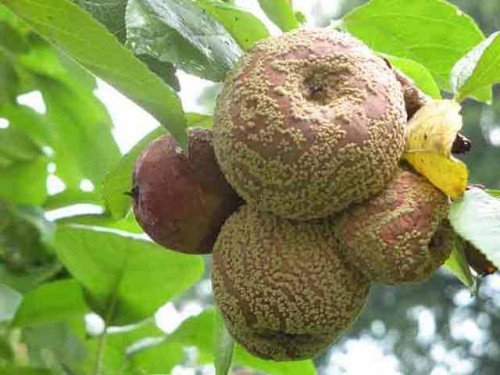

Fruit rot on apple fruits


Cytosporosis on the bark of an apple tree
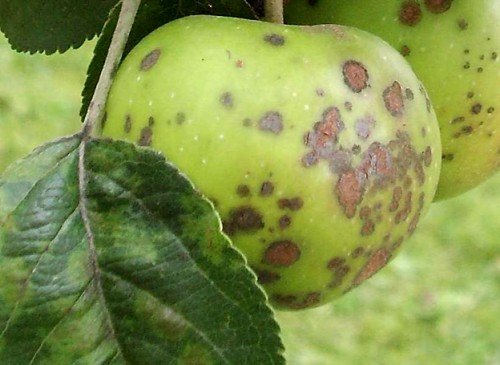

Scab on a ripening apple
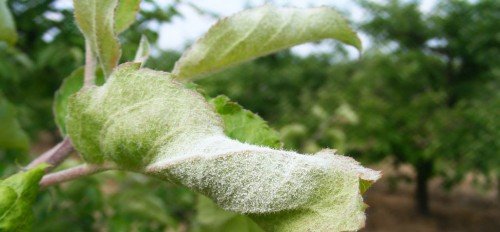

Powdery mildew on a leaf of an apple tree
Among pests, green apple aphids and moths become frequent unwanted guests of gardens. The first sucks out all the juices from the plant and depletes it, gradually leading to death, and the second eats apples, significantly spoiling the future harvest. It is necessary to deal with them immediately after detection, and even better - to carry out preventive treatment of the tree with the help of appropriate preparations.
Apple green aphids are dangerous because in warm latitudes (and they, as we remember, are preferable for the Spartan apple tree), they are capable of giving up to 16 generations per season. In small quantities, it does not pose a particular threat, but in case of mass infection, it will drink all the juice from the apple tree and deprive not only the crop, but also the tree. To get rid of wintering aphid eggs, Nitrafen is used (200 g per 10 l), which is used to treat not only the tree, but also the ground under it. Instead, you can use a green oil concentrate (KZM): 600-800 g per 10 liters of water. In summer, tobacco infusion is used: 400 g of tobacco dust is added to 10 liters of water, infused for 1 day, stirring occasionally, then filtered and 40 g of soap is added.
The moth is not so numerous, but even in small quantities it causes harm to the gardener, gnawing through the passages in ripening apples.One larva is capable of damaging three fruits, which, after visiting it, immature and fall off ahead of time. To combat it, 80% chlorophos is used, diluting 20 g in 10 liters of water. To reduce the number of caterpillars, trapping belts are used and fallen apples are collected in time, and butterflies are disposed of with the help of light and electric traps and baits in the form of an odorous liquid.
Testimonials
Tatyana. Tula region... "Hello. I live in central Russia, the climate here is average compared to other regions. I heard negative reviews about the Spartan variety. In turn, I want this apple tree characterize from the best side... The seedling took root with us quickly, there were no diseases during growth, the care consisted of feeding and pruning.
The apple tree bears fruit annually with a large number of fruits. Apples are very sweet, juicy with an interesting color. The fruits are stored for quite a long time, right up to spring.
I am very pleased with this variety, it came out on top among other apple trees and I am glad that I carefully studied the photo and description of the variety before buying. "
Svetlana. Novosibirsk region... “Apple tree Spartan grows on a dwarf rootstock. I am satisfied with the fruits and their storage, I can't say much good about the variety. I heard that this variety bears fruit abundantly, but my harvest is small. I prune the tree every spring, but the branches still freeze over. "
Sergey Ushakov. Rostov-on-Don. “I have been doing gardening for about 20 years, the garden feeds my family. I breed those varieties of apples that bring a bountiful harvest every year. The Spartan variety fully met expectations when I studied the description, photo !!! For ten years now he has been living on my site and makes me happy from year to year. The harvest increases every year, although I am already shooting under 80 kg of apples.
Due to their taste and transportability, apples are the most popular among buyers. There are some difficulties in leaving, but they are justified. "
Advantages and disadvantages


Dignity
- High rates of fertility, early maturity,
- The fruits are distinguished by good taste and aroma,
- apples have an excellent presentation,
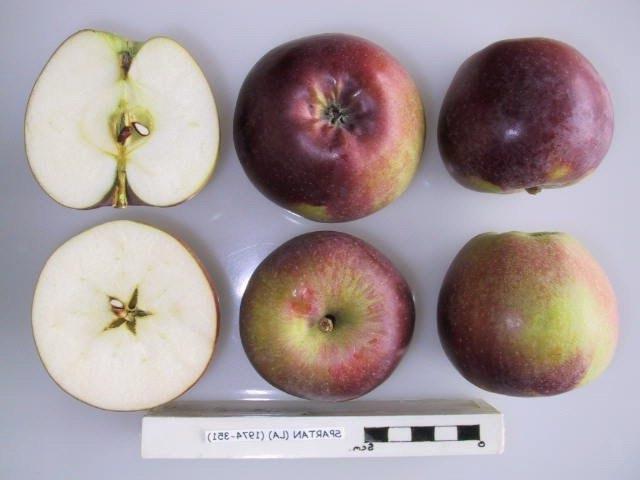

- fruits tolerate transportation well, are unpretentious,
- high resistance to many pests and diseases,
- low crumbling of fruits in all weather conditions,
- good keeping quality of apples - 4-5 months.
Disadvantages of the variety
- insufficient winter hardiness in cold regions of the country.
- shrinking of fruits with insufficient pruning of the tree, as well as with its age.
Features of planting and care


Spring care for the root zone of the Spartan variety.
Before boarding, you need to find the right drop-off site. The apple tree prefers a site with fertile soil without elevated groundwater.
Advice! Adequate lighting of the tree will prevent yield decline.
Landing
Timing
The seedling is planted in spring or autumn. Spring planting is carried out in late April, autumn - in late September and early October.
Technology
A planting hole is dug 50 cm deep and 100 cm wide.
Drainage from stones is laid at the bottom, covered with fertile soil and fertilizers.
The fertilizers include:
- Rotten manure
- Ash,
- Potassium,
- Superphosphate.
Further, straightening the rhizomes, set up a seedling and cover it with fertile soil. The root collar of the seedling should be 5 cm from the ground. After planting, the apple tree is watered and the soil is mulched.
Important! If the soil is clayey, add compost, peat and sand before planting.
Distance between trees
If several Spartan varieties are planted together, the distance between the trees should be 3 m.
From other fruit crops, the gap should be at least 4.5 m.
Growing features
For the tree to take root and develop well, there are several important points to consider:
- In the summer, the plant regular wetting by rain method is necessary. In the heat, it is recommended to water at least 2 times a week.
- To saturate the rhizomes with oxygen, loosening is carried out near the trunk circle. To avoid damage to the roots, work should be done carefully enough.
Pollinator varieties
The apple tree is a self-fertile culture. 70% of fruit ovaries originate from self-pollination. For 100% fruiting the best pollinating varieties are:
- Golden Delicious,
- Idared,
- Jonathan.
Pros and cons of the variety
Before finishing the description of the variety, I would like to highlight the advantages and disadvantages of Spartan. On the positive side, it can be noted:
- His early maturity.
- Self-pollination. There is no need to plant a pollinator tree. Moreover, if you have a Spartan apple tree in your garden, then it can pollinate other trees (of course, if they have the same flowering period).
- The fruits are juicy and have a delicate taste.
- Unlike many other trees that are afraid of scab, Spartan is not as susceptible to this disease.
- The fruits have high keeping rates. If stored properly, apples will not disappear for 6 months.
- The fruits have an amazing presentation, which allows them to be used for industrial production.
But along with this, there are also disadvantages. Among them:
- Low frost resistance. If we talk about the original Spartan, not its subspecies.
- As the tree matures, the size of the fruit becomes smaller and smaller every year.
Pruning and shaping the crown
The first pruning is carried out immediately after planting a seedlingcutting the branches by 1/3. In the future, so that the crown does not thicken, pruning is carried out every spring, eliminating weak and crooked shoots.
Attention! Do not remove lateral, regular-shaped branches, otherwise the crown will be unstable.
Canadian agricultural technology
In Canada, the Spartan apple tree is more commonly found in a dwarf form. For the development of this form, agrotechnical work must not be abused.
The tree does not need the formation and pruning of the crown.
Watering is extremely rare. Nitrogen fertilizers are also undesirable for apple trees.
BUTApple tree machinery includes:
- Top dressing,
- Identification of pests,
- Loosening the soil.
Follow-up care of the apple tree
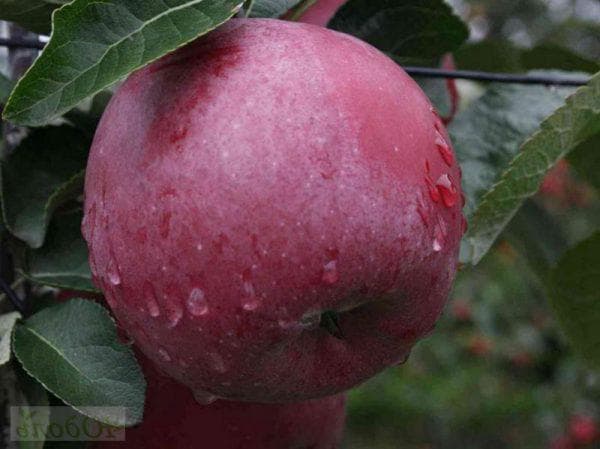

The care algorithm consists of activities familiar to gardeners, which provide the apple tree with comfortable conditions for development and fruiting.
Watering. Spartan is watered in the evening, spending 25-30 liters per tree. Experienced gardeners recommend using drip irrigation for apple trees in hot regions. In the rainy period, it must be canceled, but punctures should be made along the diameter of the trunk circle.
Top dressing. The optimal amount of nutrient mixtures is 4 times per growing season:
- The first at the time of tying flower buds. You will need organic matter or urea.
- At the onset of the apple blossom phase, a composition of 0.25 kg of urea, 0.5 kg of superphosphate, 0.4 kg of potassium sulfate is used. The components are diluted in 100 liters of water and each tree is watered with fertilizer in a volume of 15 liters for a young seedling and 50 liters for an adult Spartan apple tree.
- At the time of fruiting, 30 liters of composition –10 g of sodium humate, 0.5 kg of nitrophoska, 100 liters of water are consumed per tree.
- When the crop is harvested, you need to scatter 0.3 kg of potassium sulfate and superphosphate around the trunk. Top dressing of an apple tree is carried out in wet weather or diluted with water.
Pruning. Form the tree in the spring before flowering. In the first year, it is necessary to remove the apical bud and shoots located above. Subsequent pruning focuses on the lateral branches, leaving them room for growth.
Autumn preparation. The apple tree of the variety has not very high frost resistance, therefore, it will not overwinter without additional protection. As soon as the first frosts begin, the tree is watered and mulched with peat with a layer thickness of 30 cm.
If agricultural technology is not followed, then the Spartan variety can be affected by crop diseases.
- Scab.At the first sign, remove all damaged apples and treat the tree with Horus or Fast.
- Powdery mildew rarely affects the Spartankraine apple tree. Salvation will be the drug "Strobi" and removal of the affected parts.
- Cytosporosis. With this disease, the tree is treated with "Fundazol" or "Hom".
- Fruit rot. So that the yield does not decrease, preventive treatments are carried out with the Skor preparation.
- Apple moth. Spraying with the "Fastan" insecticide repels the pest.
- Apple flower beetle. Saves from gluttonous caterpillars "Tsimbush".
All affected parts of the Spartan apple tree are burned.
Features of ripening and fruiting
The beginning of fruiting
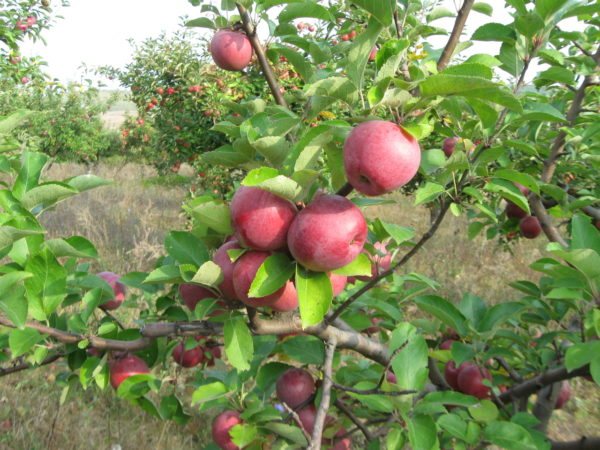

Apple tree "Spartan".
Spartan variety - pretty early culture.
With the seed method of reproduction fruiting occurs at 4 - 5 years.
With a vegetative rootstock the first harvest can be obtained for 2 years.
Bloom
The flowering period falls on month of may.
The tree has abundant, white flowers with a pronounced aroma.
Harvest time
Fruit crumbling apple tree is not typical.
Apples are pretty tight on the stem. The harvest period is in the month of September or later, at the beginning of October.
Ripening terms
After harvesting the fruits, you should not rush to eat them. The longer the fruits lie, the more they ripen and acquire a pleasant aroma and rich taste.
Features of fruiting
Fruiting depends on correct agrotechnical work.
If the crown is formed incorrectly, the apples become much smaller.
With insufficient feeding and frosting of the tree in winter and spring, periodicity in fruiting cannot be avoided.
Why doesn't it bear fruit?
If in the spring the tree blooms profusely, but the fruits are not tied, you should pay attention to the following factors:
- The tree has not reached the fruiting age.
- The presence of pests that eat up the color, preventing them from forming into fruits.
- The tree was damaged during the winter.
- The apple tree has reached the age when fruiting ends.
Storage periods
The Spartan variety is also valued for the fact that its fruits are subject to long storage... With the right temperature and humidity, apples not only improve their qualities, but they also last for 7 months.
Advice! In the refrigerator, apples retain their presentation longer than in the cellar.
The harvest
The fruits ripen almost simultaneously at the end of September. The quality of the highest grade apples is about 80%. With regular watering, the weight of the fruit can reach about 150 grams. Despite such a significant weight, thanks to a strong stalk, the fruits are confidently holding on to the branches until fully ripe. The correct storage conditions (cellar or cold rooms) allow you to maintain the presentation and taste until March - April.


Subspecies and variants
Rootstocks
Dwarf
For the cultivation of an apple tree on a dwarf rootstock, Budagovsky's red-leaved paradise will serve.
The tree has a height of about 2 m, which makes it easier to care for the plant.
Fruiting occurs in the 3rd year after vaccination.
With proper feeding, the fruits are much larger than that of the standard variety.
And the root system can tolerate up to minus 15 degrees, which makes this variety more winter-hardy.
Important! The disadvantages of the dwarf rootstock are the freezing of the stem in the winter and burns of the crown in the summer.
Semi-dwarf
In all regions of Ukraine and in some regions of Russia semi-dwarf rootstock is widespread Spartan varieties.
This kind of apple tree was bred by the Russian breeder Budakovsky. VI The variety has a high drought resistance and frost resistance.
The average height of the tree is 3.5 m. Fruiting begins in the 4th year after planting.
The variety has a high and stable yield. The root system is well developed, due to which it tolerates extreme soil conditions.
Columnar
The columnar Spartan does not exist. Let's talk in general about columnar apple trees.
The apple tree on a columnar rootstock has a straight trunk, which does not bend with a bountiful harvest.
Characteristic feature of this type is that the branches grow horizontally upward and do not require pruning. Apples are evenly distributed around the stem, starting at 35 cm from the soil.
Important! A fruit culture on a columnar rootstock is considered more winter-hardy and resistant to diseases of a different nature.
Varieties
Late
Late apple tree Spartan, unlike the others, has a high yield - up to 165 kg of apples from one tree.
The fruits weigh about 130 grams. with good transportability up to 2 months.
The apple tasting score is 5 points.
The fruits are used fresh, in conservation, making jams and liqueurs.
The variety is more frost-resistant and has a fairly good immunity to powdery mildew and scab.
Winter
The Newtown apple tree was not used in the breeding of the winter variety.
The tree has a rounded crown with small leaves.
Fruiting the variety lasts from late September to the third decade of October. Fruiting is regular. Fruits are small, no more than 100 gr.
With proper care and preparation for the winter period can tolerate a temperature drop of up to 35 degrees.
Fruit
Spartan apples are of medium size - 90-120 g, spherical or rounded-conical with a weakly pronounced ribbing. The main cover is light yellow, most of the fruit is a burgundy-red blush. The smooth surface contains a waxy coating.
The pulp is juicy, firm, white with a rich aroma and sweet taste without sourness.
Tasting score - 5 points.
The variety belongs to the table variety - the crop of universal purpose is suitable for fresh consumption, preparation of juice, compotes, cider, preserves, jam, jam and drying.
The tree blooms in mid or late May, depending on the climatic zone. The flowers are white or light pink, small, thinning the pleasant aroma, densely covering the entire crown. Fruits are harvested in late September or early October.
For apples to lie for a long time, they must be removed in warm and dry weather, along with the stalks.
Fruits ripen at the same time, they are harvested in one go: they are placed in wooden boxes and sent to storage in a cool and dark place, where the temperature is 1-5 ° C, humidity is at 70-75% and there is good ventilation. Under these conditions, the harvest lasts from 4 to 7 months.
Features of cultivation in different regions
In outskirts of Moscow
In the Moscow region, there are short-term severe frosts in the winter and rather high temperatures in the summer. Not every apple variety will be able to take root in this region.
The Spartan apple tree on a semi-dwarf rootstock is best suited for these climatic conditions.
Due to its rapid growth, the apple tree will be able to replace the branches damaged in winter with new shoots.
When planting a seedling, it is necessary to add compost, peat and humus to the soil, which will serve for good survival and development.
Advice! This region requires regular watering of the apple tree, which will contribute to regular fruiting.
In Siberia
Siberia has very harsh climatic conditions, the temperature in winter can reach minus 50 degrees.
It is quite difficult to breed the Spartan apple tree here, even with a dwarf and semi-dwarf rootstock.
For the best result for apple rootstocks, semi-wild varieties with frost-resistant rhizomes and stale crown forms are used.
Upon receipt of a successful vaccination, the crown is formed so that in winter it is under the snow and does not freeze.
Important! With all the requirements for caring for an apple tree, regular fruiting in this region is extremely rare.
In Belarus
Despite the fact that Belarus has a favorable climate for the development of the Spartan apple tree, cool weather and high rainfall contribute to the appearance and development of scab.
This disease leads to reduced yields and periodicity in fruiting. To avoid this, one should examine every year and detect the disease at an early stage.
In the Urals
In the Urals, climatic weather conditions are similar to those in Siberia. It is quite difficult to grow the Spartan variety here. With proper care and insulation, the apple tree in this region has a good yield.
In the middle lane
Due to its low winter hardiness, the Spartan apple variety rarely bred in central Russia... If you nevertheless decide to purchase a seedling, the late Spartan will be the best choice.
It is more frost-resistant and, with proper care, may not freeze in winter.
Important! In central Russia, regular watering and loosening of the soil is required.
In the Northwest of Russia
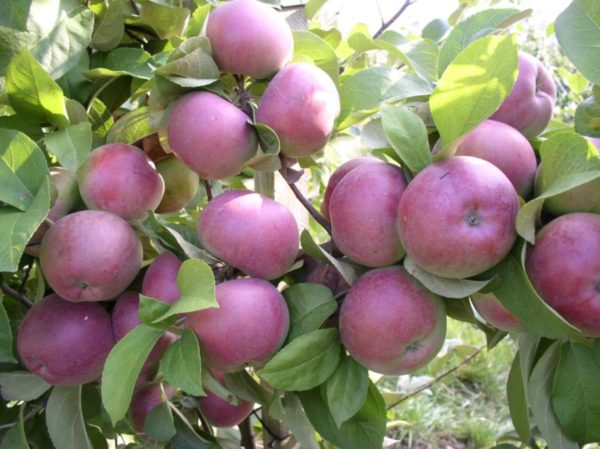

Spartan variety.
In the North-West of Russia, the winter variety Spartan takes root better.
In order to avoid freezing of the upper branches of the apple tree, the crown in this region is formed in a shale form.
In Ukraine
The Spartan variety was zoned to Ukraine in the 80s.
Due to the fact that the climatic conditions are suitable for the development of the apple tree, the variety quickly gained its popularity and spread to the northern, northeastern and eastern regions of Ukraine.
Gardeners' opinion
Due to its good productivity, long-term storage and the possibility of growing on different rootstocks, the Spartan apple tree has become widespread throughout Russia.
Despite some shortcomings, gardeners who have been growing this crop for several years note a stable and annual yield, trees practically do not get sick and do not freeze with good shelter.
According to the gardeners of the North and the Middle Lane, the care is quite laborious, but worthwhile - proper and regular nutrition, watering and good shelter for the winter allow you to achieve good yields.
The chemical composition of fruits, their benefits and harms
The fruits of this variety contain almost 11% sugars, they are rich in ascorbic acid (vitamin C) - 4.6 mg per 100 g. They also contain more than 11% pectin, P-active substances - 160.2 mg per 100 g, titrated ( tartaric) acids - 0.32%.
Apples are saturated with potassium, calcium, iron, vitamins A, B E, PP, folic acid.
These apples are a low-calorie product that allows you to keep fit. They also help those who want to lose weight.
They have a beneficial effect on the entire body, but are especially useful for the health of the heart, blood vessels and digestive organs. Due to the abundance of fiber, they cleanse the intestines well, pectin helps to maintain skin tone. And ascorbic acid is a powerful agent for strengthening the immune system, helps in the fight against viruses and infections.
These apples act negatively only if they are eaten in large quantities for people suffering from gastritis and ulcers.
Planting and caring for columnar fruit trees

